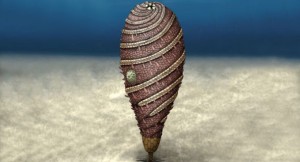According to Tia Ghose, who penned the article “Bizarre, cigar-shaped creature unearthed in Morocco” for LiveScience, in 2012 scientists in Morocco discovered specimens of a fossilized, cigar-shaped creature that lived about 520 million years ago in the country’s Anti-Atlas Mountains. The new species has been designated Helicocystis moroccoensis, a primitive echinoderm, which is the group of animals that includes sea urchins, starfish, and sea cucumbers.
The announcement of this newly discovered species appeared in the journal Proceedings of the Royal Society B on June 25, 2013, under the title, “Cambrian spiral-plated echinoderms from Gondwana reveal the earliest pentaradial body plan.” According to study co-author Andrew Smith, a paleontologist at London’s Natural History Museum, Helicocystis moroccoensis exhibits “[C]haracteristics that place it as the most primitive echinoderm that has fivefold symmetry.” According to the Oceanic Research Group, this is a common characteristic of echinoderms, in that the appendages point outwards from the center of the animal’s body, and while fivefold symmetry is common, there are a number of exceptions.
Researchers described Helicocystis moroccoensis as a “transitional animal” that could change its body from slender to stout, and highlighted the specimen’s value in understanding the early development of echinoderms. The ancient echinoderm existed on the prehistoric supercontinent called Gondwana during the Cambrian Explosion, when all of the creatures then in existence inhabited the Earth’s seas.
According to Smith, “It’s a cigar-shaped beast, and it was able to expand and contract that cigar shape…Sometimes it could be short and fat, and sometimes it could be long and thin.”
Helicocystis moroccoensis had a cylindrical body with a maximum length of 1.6 inches. Its mouth was on the top of its body, and had a small, checkered plate stem on its base, as well as a lattice-like skeleton of calcite. The echinoderm morphed its shape using a spiraling arrangement of five ambulacra – the oldest known echinoderm with such an arrangement – which are essentially protrusions from the mouth that opened and closed to catch food floating by.
Other echinoderms were found in the samples excavated by Smith and his team of researchers, and the diversity among the group of closely related sea creatures served as but one example of the unique nature of the Cambrian Explosion. Said Smith, “The important thing about the whole fauna is that there is already, by this time, a remarkable diversity in body form…And yet this is only 10 [million] to 15 million years after the calcite skeleton evolved.”








